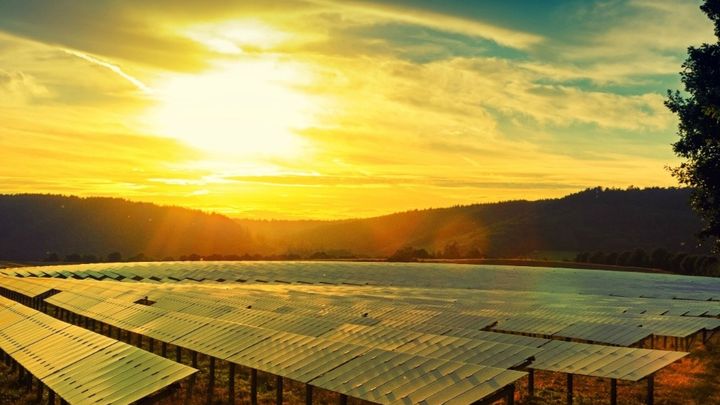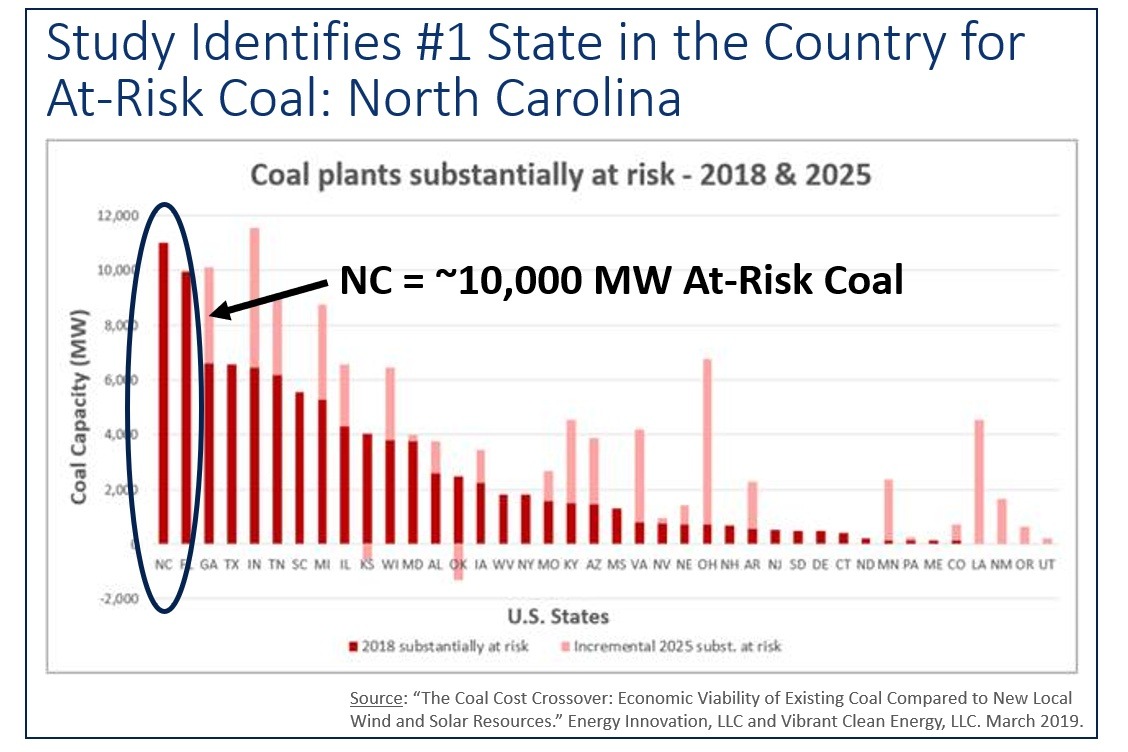Tyler Norris is fundraising

Transition the Carolinas from Coal to Renewables
I love the Carolinas, and I believe our region can help lead the country toward the sustainable, low-carbon future we need.
That’s why I’m honored to receive the 2019 Clean Energy Leader of the Year Award from one of the region's most respected and long-standing environmental organizations, the NC Sustainable Energy Association (NCSEA).
I’m dedicated to paying it forward, so this holiday season I'm personally committing to match up to $1,000 in donations to help our region accelerate its transition to clean energy in 2020.
I’d like to explain why this moment is so important, and invite you to join me in this effort.
2020 represents a pivotal year for our region’s energy future, when all the major utilities will propose new resource plans to supply nearly 15 million consumers across the Carolinas. Those resource plans could speed our transition to clean energy – or maintain the status quo.
Our region has made remarkable progress, and what happens here matters. NC has been the country’s 2nd largest solar market and set a standard across the Southeast, and SC is quickly catching up. We’ve demonstrated how to build broad support for renewable energy across purple and red districts.
We can build on this momentum, but we face tough obstacles. For all our progress, we still maintain more uneconomic coal than any U.S. region [1] [2]. Those coal plants impose billions of dollars in unnecessary costs on ratepayers [3], and their waste continues to pollute our air and poison our water – and contribute to life-threatening extreme weather along our coasts.
Left unchecked, the utilities will lock us into a fossil fuel-dominated future, slowing the deployment of renewables in favor of a mass buildout of gas power plants and pipelines. The region’s largest utility currently seeks to build over $12 billion in gas plants and is constructing a $7 billion gas pipeline, while stalling renewables beyond the mid-2020s.
We can’t let it happen. It’s essential that independent watchdog organizations have resources to provide a check on these utility resource plans, including access to leading experts, state-of-the-art analysis, and analytical tools.
Unfortunately, the playing field is tilted heavily toward the utilities, which continue to have formidable structural advantages. As one example, the utilities are authorized to recover all costs of their regulatory interventions – including millions of dollars in attorney fees and expensive studies commissioned solely by the utilities, all expensed to ratepayers. In contrast, independent watchdogs have to rely on charitable contributions to challenge the utility proposals.
For all these reasons, every contribution makes a significant difference. All funds will be used by the Energy Transition Institute to develop analysis and raise awareness about the opportunity to speed the deployment of clean energy in the Carolinas, supporting the efforts of organizations like NCSEA and other stakeholders.
Thank you in advance for your contribution to this cause!
About the Energy Transition Institute
The mission of the Energy Transition Institute (ETI) is to educate emerging leaders and the general public about the benefits of transitioning to environmentally responsible energy sources, through evidence-based educational resources, analytical tools, and public forums. ETI is a 501(c)(3) nonprofit, nonpartisan organization, incorporated in North Carolina. www.energytransitions.org


[1] “Half of U.S. Coal Fleet on Shaky Economic Footing: Coal Plant Operating Margins Nationwide.” BNEF. March 2018. https://www.bloomberg.com/news/articles/2018-03-26/half-of-all-u-s-coal-plants-would-lose-money-without-regulation
[2] “The Coal Cost Crossover: Economic Viability of Existing Coal Compared to New Local Wind and Solar Resources.” Energy Innovation, LLC and Vibrant Clean Energy, LLC. March 2019. https://energyinnovation.org/wp-content/uploads/2019/03/Coal-Cost-Crossover_Energy-Innovation_VCE_FINAL.pdf
[3] NCSEA Initial Comments, Attachment 1 from Synapse Energy Economics entitled North Carolina’s Clean Energy Future: An Alternative to Duke’s Integrated Resource Plan, Commission Docket E-100 Sub 157, March 7, 2019. https://starw1.ncuc.net/NCUC/ViewFile.aspx?Id=891ac0cc-7aa9-4835-aed2-b15e9b5713e6
Photo credit: Shutterstock.com
That’s why I’m honored to receive the 2019 Clean Energy Leader of the Year Award from one of the region's most respected and long-standing environmental organizations, the NC Sustainable Energy Association (NCSEA).
I’m dedicated to paying it forward, so this holiday season I'm personally committing to match up to $1,000 in donations to help our region accelerate its transition to clean energy in 2020.
I’d like to explain why this moment is so important, and invite you to join me in this effort.
2020 represents a pivotal year for our region’s energy future, when all the major utilities will propose new resource plans to supply nearly 15 million consumers across the Carolinas. Those resource plans could speed our transition to clean energy – or maintain the status quo.
Our region has made remarkable progress, and what happens here matters. NC has been the country’s 2nd largest solar market and set a standard across the Southeast, and SC is quickly catching up. We’ve demonstrated how to build broad support for renewable energy across purple and red districts.
We can build on this momentum, but we face tough obstacles. For all our progress, we still maintain more uneconomic coal than any U.S. region [1] [2]. Those coal plants impose billions of dollars in unnecessary costs on ratepayers [3], and their waste continues to pollute our air and poison our water – and contribute to life-threatening extreme weather along our coasts.
Left unchecked, the utilities will lock us into a fossil fuel-dominated future, slowing the deployment of renewables in favor of a mass buildout of gas power plants and pipelines. The region’s largest utility currently seeks to build over $12 billion in gas plants and is constructing a $7 billion gas pipeline, while stalling renewables beyond the mid-2020s.
We can’t let it happen. It’s essential that independent watchdog organizations have resources to provide a check on these utility resource plans, including access to leading experts, state-of-the-art analysis, and analytical tools.
Unfortunately, the playing field is tilted heavily toward the utilities, which continue to have formidable structural advantages. As one example, the utilities are authorized to recover all costs of their regulatory interventions – including millions of dollars in attorney fees and expensive studies commissioned solely by the utilities, all expensed to ratepayers. In contrast, independent watchdogs have to rely on charitable contributions to challenge the utility proposals.
For all these reasons, every contribution makes a significant difference. All funds will be used by the Energy Transition Institute to develop analysis and raise awareness about the opportunity to speed the deployment of clean energy in the Carolinas, supporting the efforts of organizations like NCSEA and other stakeholders.
Thank you in advance for your contribution to this cause!
About the Energy Transition Institute
The mission of the Energy Transition Institute (ETI) is to educate emerging leaders and the general public about the benefits of transitioning to environmentally responsible energy sources, through evidence-based educational resources, analytical tools, and public forums. ETI is a 501(c)(3) nonprofit, nonpartisan organization, incorporated in North Carolina. www.energytransitions.org


[1] “Half of U.S. Coal Fleet on Shaky Economic Footing: Coal Plant Operating Margins Nationwide.” BNEF. March 2018. https://www.bloomberg.com/news/articles/2018-03-26/half-of-all-u-s-coal-plants-would-lose-money-without-regulation
[2] “The Coal Cost Crossover: Economic Viability of Existing Coal Compared to New Local Wind and Solar Resources.” Energy Innovation, LLC and Vibrant Clean Energy, LLC. March 2019. https://energyinnovation.org/wp-content/uploads/2019/03/Coal-Cost-Crossover_Energy-Innovation_VCE_FINAL.pdf
[3] NCSEA Initial Comments, Attachment 1 from Synapse Energy Economics entitled North Carolina’s Clean Energy Future: An Alternative to Duke’s Integrated Resource Plan, Commission Docket E-100 Sub 157, March 7, 2019. https://starw1.ncuc.net/NCUC/ViewFile.aspx?Id=891ac0cc-7aa9-4835-aed2-b15e9b5713e6
Photo credit: Shutterstock.com
- P
- S
- A
7 supporters
